Unveiling the Impact of UV on Your Eyes: Tips for Eye Health this Summer
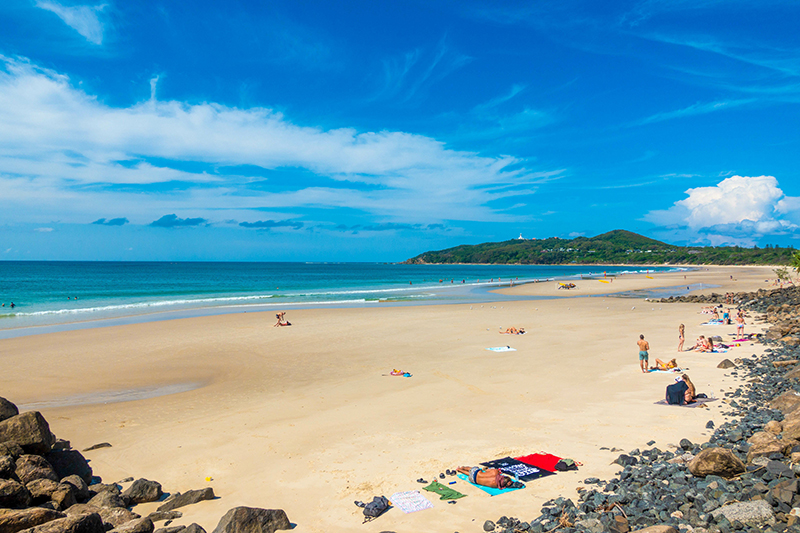
In Australia's summer, many people bask in the brilliance of the sun, reveling in this vast and beautiful land.
The lush blue sky, sparkling white sandy beaches, and the clear sea at beautiful beaches, outdoor barbecues, and camping and other outdoor activities in the expansive nature with family and friends. They are savouring the charm of Australia's summer to the fullest.
While outdoor activities are fantastic, one crucial aspect we must not forget is the consideration of ultraviolet (UV) radiation. We are sure you all have a good awareness of UV exposure, but especially when it comes to the health of your eyes, why not take a moment to reevaluate what you can do?
Understanding UV Radiation: A Key to Safe Outdoor Fun
What is the meaning of UV rays?
UV rays, or ultraviolet rays, are classified into three main categories: UV-A, UV-B, and UV-C.
- Ultraviolet A (UV-A): This is the long-wave UV, also known as "soft UV," and it is not blocked by the ozone layer. UV-A exposure is primarily associated with skin ageing.
- Ultraviolet B (UV-B): UV-B falls into the medium UV range and is mostly absorbed by the ozone layer. It is commonly associated with skin burns and falls in the intermediate UV category.
- Ultraviolet C (UV-C): UV-C is the short-wave ultraviolet, often referred to as "hard UV." It is completely absorbed by the ozone layer and the Earth's atmosphere.
As you may know, Australia's heightened exposure to UV radiation is attributed to our geographical location, a thinner ozone layer, and various contributing factors. This unique combination makes it imperative to take protective measures against the sun's harmful rays.
In Australia, UV levels are at their highest during the summer season, owing to factors such as the sun's proximity, the thinning of the ozone layer, and other contributing elements.
Click here to find out more.
How does UV radiation affect our bodies?
Excessive exposure to ultraviolet (UV) radiation can primarily have the following effects on our bodies:
Acute Effects:
- Sunburn, Sun Tan
- Ultraviolet Keratitis (Snow Blindness)
Chronic Effects:
Skin:
- Wrinkles
- Sunspots
- Benign Tumours
- Precancerous Conditions (Actinic Keratosis, Dysplastic Nevi)
- Skin Cancer
- Pterygium
- Cataracts
Let's delve deeper into eye issues caused by UV exposure
Ultraviolet Keratitis:
Ultraviolet keratitis is an acute inflammation of the cornea that occurs when it is exposed to strong UV radiation. Typically, symptoms manifest within a few hours to 24 hours after exposure and may include a sensation of foreign objects in both eyes, intense pain, tearing, redness, photophobia, and sometimes difficulty in opening the eyelids. A well-known condition associated with this is snow blindness, particularly in locations with strong UV reflection like snowy surfaces.
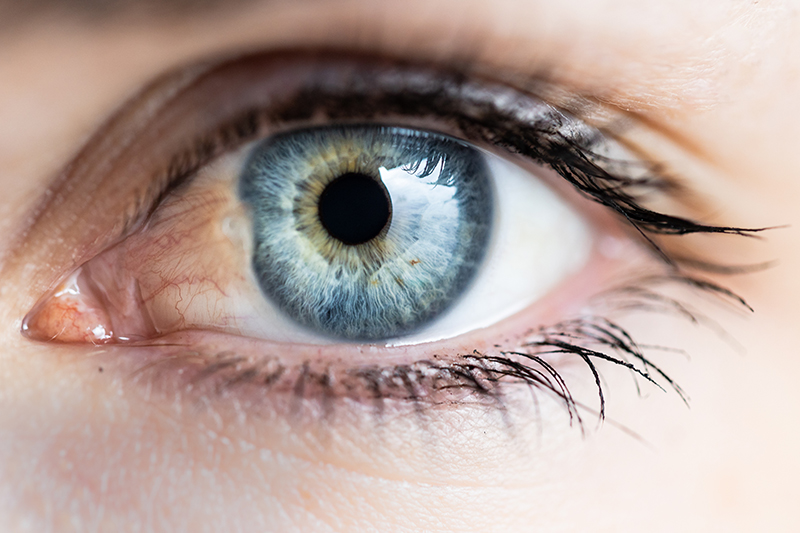
Pterygium is a triangular-shaped growth of the conjunctiva that invades the nasal side of the cornea. It can be triggered by factors such as UV radiation, ageing, or chronic irritation from extended use of contact lenses. Symptoms include eye redness, a sensation of foreign objects in the eye, and the growth of the pterygium, resulting in white opacity and elevation on the cornea. If it advances towards the centre of the cornea, it can exacerbate astigmatism and lead to decreased vision, necessitating surgical removal.
Cataract:
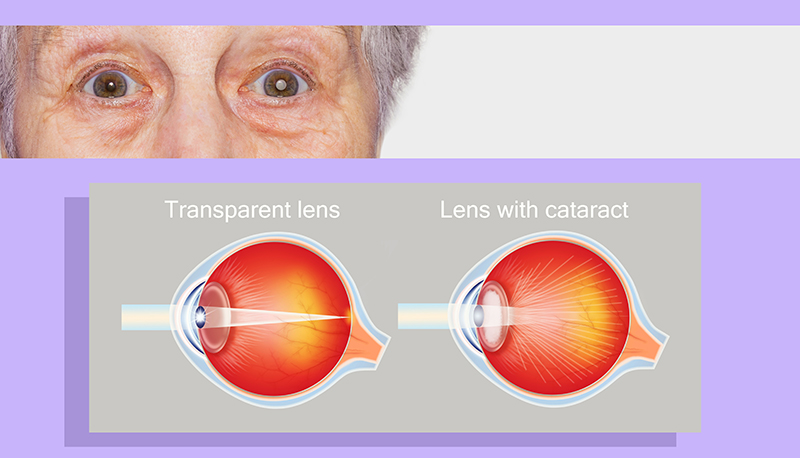
Cataract is one of the most common eye diseases and results from the clouding of the eye's lens, which is responsible for focusing light onto the retina. This clouding obstructs light from reaching the retina, resulting in a decrease in the quality of vision. In its early stages, cataracts may lead to presbyopia as the lens hardens, and as they progress, vision deteriorates and can eventually lead to blindness. While there are over 80 types of cataracts, age-related cataracts are the most common and have a known association with exposure to UV radiation. Intense and prolonged UV radiation can accelerate the onset of cataracts and, if you already have cataracts, it can speed up their progression. Treatment typically involves the surgical replacement of the cloudy lens with an intraocular lens.
Protecting Your Eyes: Warding Off UV-Related Ailments
Wear Appropriate Sunglasses
While many people consider using sunglasses when the sun is strong or while driving, it's crucial to recognize that the impact of ultraviolet rays is present even on cloudy days or during different seasons. Therefore, it's important to always wear sunglasses.
By choosing sunglasses that meet the strict standards of countries like Australia and New Zealand and offer high UV protection, you can protect your eye health from harmful UV rays.
Wear UV-filtered Contact Lenses
Unfortunately, sunglasses with UV protection alone cannot block all UV rays. In fact, UV rays can enter through the gaps between the sunglasses and your face.
The diagram below demonstrates how UV rays can get through to your eyes.
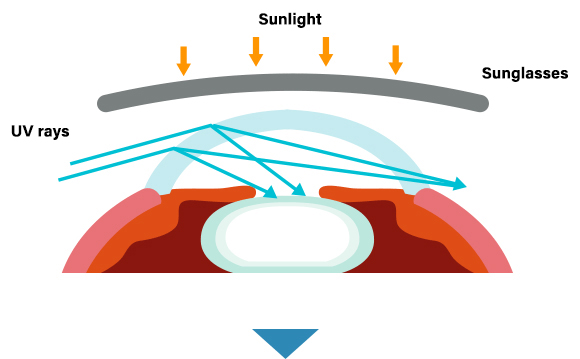
The diagram below showcases how UV rays are blocked off with the dual protection of sunglasses and UV lenses.
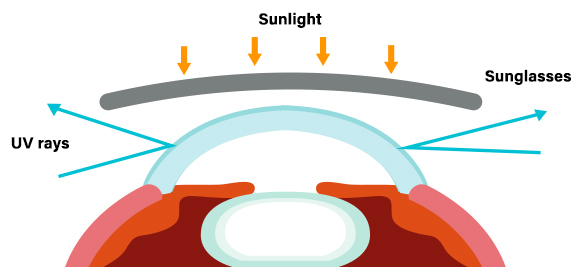
Luckily at Quicklens, we sell a range of contact lenses with UV protection! Below we’ve put together a list of lenses we highly recommend with great UV protection.
Qieto1day (30 Pack) (Daily)
Experience the excellence of our exclusive and highly sought-after daily affordable contact lenses!
Don't miss out on this limited-time offer: Get up to 50% off the base price when you purchase Qieto1day up to 2 boxes!
First time customers? Use Code: SQTR
Existing customers? Use Code: SQSW
(Limit one coupon per customer.Promotion subject to change without prior notice.)
Acuvue Oasys 1-Day With HydraLuxe (30 Pack) (Daily/Silicone hydrogel)
Daily contact lenses from the popular Acuvue brand, and are made of silicone hydrogel, a premium material for contact lenses.
Acuvue Oasys (6 Pack) (Fortnightly/Silicone hydrogel)
One of the most popular contact lenses in the market. It’s made of silicone hydrogel, a premium material for contact lenses.
Qieto1day Color (Colour (Circle))
Another exclusive and affordable type of colour circle lenses. There are three colours available to choose from.
Don't miss out on this limited-time offer: Get up to 50% off the base price when you purchase up to 2 boxes!
First time customers? Use Code: SQCT
Existing customers? Use Code: SQCS
(Limit one coupon per customer.Promotion subject to change without prior notice.)
Click here to browse for all other UV-filtered contact lenses,
You're likely already taking the necessary precautions in your daily life, such as applying sunscreen to protect your skin. Additionally, consider wearing sunglasses or using contact lenses with UV filters to shield your eyes from UV radiation, among other measures. By incorporating these precautions, you can fully enjoy Australia's wonderful summer while safeguarding your skin and eyes.

